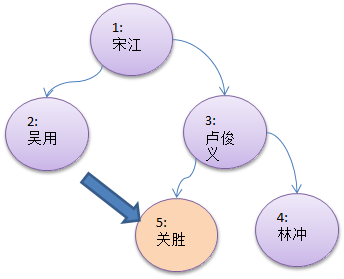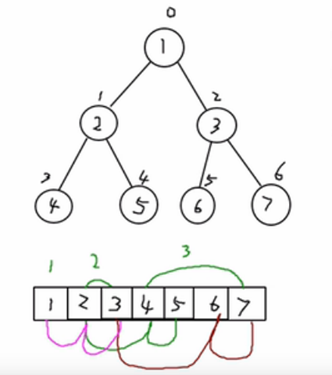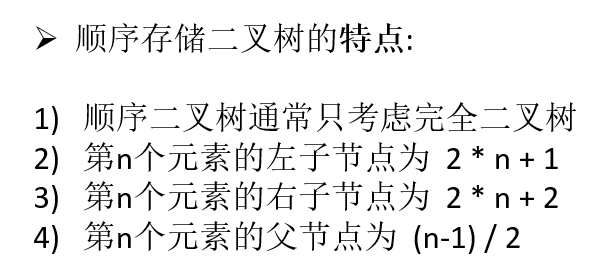一、为什么需要树
1. 当前存储数据的方式及问题
1、数组
优点:通过下标方式访问元素,速度快。对于有序数组,还可使用二分查找提高检索速度。
缺点:如果要检索具体某个值,或者插入值(按一定顺序)会整体移动,效率较低。数组是提前分配空间的,所以当空间满的时候,再插入数值则需要重新创建新的数组,把原来的值复制到新数组后才能实现插入(数组扩容)。
ArrayList底层也是数组,是object[10],按找一定比例(1.5倍)进行扩容,而不是一个一个扩容;
2. 链式存储
优点:在一定程度上对数组存储方式有优化(比如:插入一个数值节点,只需要将插入节点,链接到链表中即可, 删除效率也很好)。
缺点:在进行检索时,效率仍然较低,比如(检索某个值,需要从头节点开始遍历)
3. 树的存储
能提高数据存储,读取的效率, 比如利用 二叉排序树(Binary Sort Tree),既可以保证数据的检索速度,同时也可以保证数据的插入,删除,修改的速度。
二、二叉树的前序/中序/后序遍历
1. 概念
前序遍历:父—-左—-右
中序遍历:左—-父—-右
后序遍历:左—-右—-父
2. 代码实现
1. 创建node节点
// 先创建节点class HeroNode{private int no;private String name;private HeroNode left; // 可以默认为空,所以构造器中可以不包含此项private HeroNode right;public HeroNode(int no, String name) {this.no = no;this.name = name;}public int getNo() {return no;}public void setNo(int no) {this.no = no;}public String getName() {return name;}public void setName(String name) {this.name = name;}public HeroNode getLeft() {return left;}public void setLeft(HeroNode left) {this.left = left;}public HeroNode getRight() {return right;}public void setRight(HeroNode right) {this.right = right;}@Overridepublic String toString() {return "HeroNode{" +"no=" + no +", name='" + name + '\'' +'}';}// 前序public void preOrder(){System.out.println(this); // 先输入当前节点// 递归输出左子树if(this.left!=null){this.left.preOrder();}// 递归向右子树前序遍历if(this.right!=null){this.right.preOrder();}}// 中序public void infixOrder(){// 递归输出左子树if(this.left!=null){this.left.infixOrder();}System.out.println(this); // 先输入当前节点// 递归向右子树中序遍历if(this.right!=null){this.right.infixOrder();}}// 后序public void postOrder(){// 递归输出左子树if(this.left!=null){this.left.postOrder();}// 递归向右子树中序遍历if(this.right!=null){this.right.postOrder();}System.out.println(this); // 先输入当前节点}}
2. 创建二叉树
// 定义二叉树
class BinaryTree{
HeroNode root;
public BinaryTree(HeroNode root) {
this.root = root;
}
// 前序遍历
public void preOrder(){
if(this.root!=null){
this.root.preOrder();
}else {
System.out.println("二叉树为空,无法遍历");
}
}
// 中序遍历
public void infixOrder(){
if(this.root!=null){
this.root.infixOrder();
}else {
System.out.println("二叉树为空,无法遍历");
}
}
// 后序遍历
public void postOrder(){
if(this.root!=null){
this.root.postOrder();
}else {
System.out.println("二叉树为空,无法遍历");
}
}
}
3. 二叉树—-查找指定节点
查找的逻辑是: 判断当前节点是否是目标节点,如果不是,则再用其左右节点来调用当前查找的方法。
3.1 前序遍历查找
落脚点还是判断 this.no==no
// 前序遍历查找
public HeroNode preOrderSearch(int no) {
if (this.no == no) {
return this;
}
// 如果不是当前节点,则判断是否是其左子节点
HeroNode resultNode = null;
if (this.left != null) {
// 如果找到了才右返回值“this”,否则为空
resultNode = this.left.preOrderSearch(no);
}
if (resultNode != null) {
return resultNode;
}
// 左递归没找到,则判断右递归
if (this.right != null) {
// 如果找到了才右返回值“this”,否则为空
resultNode = this.right.preOrderSearch(no);
}
return resultNode;
}
3.2 中序遍历查找
落脚点还是判断 this.no==no
// 中序遍历查找
public HeroNode infixSearch(int no){
HeroNode resultNode = null;
if(this.left!=null){
resultNode=this.left.infixSearch(no); // 当前方法有一个返回值,用此临时变量来接收此返回值
}
if(resultNode!=null){
return resultNode; // 如果找到了就直接返回,不再继续
}
if(this.getNo()==no){
return this;
}
if(this.right!=null){
resultNode=this.right.infixSearch(no);
}
return resultNode;
}
3.3 后续遍历查找
落脚点还是判断 this.no==no
// 后续遍历
public HeroNode postSearch(int no){
HeroNode resultNode = null;
if(this.left!=null){
resultNode = this.left.postSearch(no);
}
if(resultNode!=null){
return resultNode;
}
if(this.right!=null){
resultNode=this.right.postSearch(no);
}
if(resultNode!=null){
return resultNode;
}
if(this.getNo()==no){
resultNode=this;
}
return resultNode;
}
三、二叉树的节点删除
1. 逻辑思维

如果删除的是5号,则需要在其父节点3号上进行判断, 即 if 3.left == target, 3.left =null;
2. 代码实现
2.1 node类中
// 递归删除节点
public void deleteNode(int no) {
if (this.left != null && this.left.getNo() == no) {
this.left = null;
return;
}
if (this.right != null && this.right.getNo() == no) {
this.right = null;
return;
}
// 需要向左子树递归删除
if (this.left != null) {
this.left.deleteNode(no);
}
if (this.right != null) {
this.right.deleteNode(no);
}
}
2.2 binaryTree类中
public void delNode(int no){
if(root!=null){
//如果只有一个root
if(root.getNo()==no){
root=null;
}else {
// 开始递归删除
root.deleteNode(no);
}
}else {
System.out.println("空的二叉树,没有目标值");
}
}
四、二叉树的2种存储结构
4.1 顺序存储二叉树
把数组的值当作二叉树的形式存入,则需要使用数组的下标对应二叉树的位置信息;
只针对完全二叉树使用;
1. 逻辑思维
2. 代码实现
3.1 顺序存储—-前序遍历
先写一个数组,按照顺序存储的逻辑,将数值依次存入此数组中。 关键点就是index(即上图中的n)
package com.atguigu.tree;
public class ArrayBinaryTreeDemo {
public static void main(String[] args) {
int[] arr = {1,2,3,4,5,6,};
}
}
// 写一个ArrayBinaryTree类来存储数据实现二叉树遍历
class ArrayBinaryTree{
private int[] arr;
public ArrayBinaryTree(int[] arr) {
this.arr = arr;
}
// 为了使代码简洁,重载方法,每次都是从根节点开始前序遍历
public void preOrder(){
preOrder(0);
}
// 编写一个方法,完成顺序存储一个二叉树的前序遍历
//index: 数组元素的下标
public void preOrder(int index){
// 如果数组为空
if(arr==null||arr.length==0){
System.out.println("数组为空,不能按照二叉树的前序遍历!");
}
// 前序遍历:当前节点----》左节点----》右节点
// 输出当前数组中此元素
System.out.println(arr[index]);
if(2*index+1<arr.length){//保证下标不越界; 左子节点的写法
preOrder(index*2 +1);
}
if(2*index+2<arr.length){//保证下标不越界;右子节点的写法
preOrder(index*2 +2);
}
}
}
4.2、线索化二叉树
1. 逻辑思维
如果一个节点的左孩子为空,则指向它的前驱节点;当前序节点为空时,即指向null;
如果一个节点的右孩子为空,则指向它的后继节点。
参考链接:https://blog.csdn.net/weixin_44067399/article/details/107179420?spm=1001.2101.3001.6650.6&utm_medium=distribute.pc_relevant.none-task-blog-2%7Edefault%7EOPENSEARCH%7Edefault-6.no_search_link&depth_1-utm_source=distribute.pc_relevant.none-task-blog-2%7Edefault%7EOPENSEARCH%7Edefault-6.no_search_link&utm_relevant_index=12
2. 代码实现
2.1 中序遍历线索化二叉树
package com.atguigu.tree.threadedbinarytree;
import java.util.concurrent.SynchronousQueue;
public class ThreadedBinaryTreeDemo {
public static void main(String[] args) {
//测试一把中序线索二叉树的功能
HeroNode root = new HeroNode(1, "tom");
HeroNode node2 = new HeroNode(3, "jack");
HeroNode node3 = new HeroNode(6, "smith");
HeroNode node4 = new HeroNode(8, "mary");
HeroNode node5 = new HeroNode(10, "king");
HeroNode node6 = new HeroNode(14, "dim");
//二叉树,后面我们要递归创建, 现在简单处理使用手动创建
root.setLeft(node2);
root.setRight(node3);
node2.setLeft(node4);
node2.setRight(node5);
node3.setLeft(node6);
//测试中序线索化
ThreadedBinaryTree threadedBinaryTree = new ThreadedBinaryTree();
threadedBinaryTree.setRoot(root);
threadedBinaryTree.threadedNodes();
//测试: 以10号节点测试
HeroNode leftNode = node5.getLeft();
HeroNode rightNode = node5.getRight();
System.out.println("10号结点的前驱结点是 =" + leftNode); //3
System.out.println("10号结点的后继结点是=" + rightNode); //1
//当线索化二叉树后,能在使用原来的遍历方法
//threadedBinaryTree.infixOrder();
System.out.println("使用线索化的方式遍历 线索化二叉树");
threadedBinaryTree.threadedList(); // 8, 3, 10, 1, 14, 6
}
}
//定义ThreadedBinaryTree 实现了线索化功能的二叉树
class ThreadedBinaryTree {
private HeroNode root;
//为了实现线索化,需要创建要给指向当前结点的前驱结点的指针
//在递归进行线索化时,pre 总是保留前一个结点
private HeroNode pre = null;
public void setRoot(HeroNode root) {
this.root = root;
}
//重载一把threadedNodes方法
public void threadedNodes() {
this.threadedNodes(root);
}
//遍历线索化二叉树的方法
public void threadedList() {
//定义一个变量,存储当前遍历的结点,从root开始
HeroNode node = root;
while (node != null) {
//循环的找到leftType == 1的结点,第一个找到就是8结点
//后面随着遍历而变化,因为当leftType==1时,说明该结点是按照线索化
//处理后的有效结点
while (node.getLeftType() == 0) {
node = node.getLeft();
}
//打印当前这个结点
System.out.println(node);
//如果当前结点的右指针指向的是后继结点,就一直输出
while (node.getRightType() == 1) {
//获取到当前结点的后继结点
node = node.getRight();
System.out.println(node);
}
//替换这个遍历的结点
node = node.getRight();
}
}
//编写对二叉树进行中序线索化的方法
/**
* @param node 就是当前需要线索化的结点
*/
public void threadedNodes(HeroNode node) {
//如果node==null, 不能线索化
if (node == null) {
return;
}
//(一)先线索化左子树
threadedNodes(node.getLeft());
//(二)线索化当前结点[有难度]
//处理当前结点的前驱结点
//以8结点来理解
//8结点的.left = null , 8结点的.leftType = 1
if (node.getLeft() == null) {
//让当前结点的左指针指向前驱结点
node.setLeft(pre);
//修改当前结点的左指针的类型,指向前驱结点
node.setLeftType(1);
}
//处理后继结点
if (pre != null && pre.getRight() == null) {
//让前驱结点的右指针指向当前结点
pre.setRight(node);
//修改前驱结点的右指针类型
pre.setRightType(1);
}
//!!! 每处理一个结点后,让当前结点是下一个结点的前驱结点
pre = node;
//(三)在线索化右子树
threadedNodes(node.getRight());
}
//删除结点
public void delNode(int no) {
if (root != null) {
//如果只有一个root结点, 这里立即判断root是不是就是要删除结点
if (root.getNo() == no) {
root = null;
} else {
//递归删除
root.delNode(no);
}
} else {
System.out.println("空树,不能删除~");
}
}
//前序遍历
public void preOrder() {
if (this.root != null) {
this.root.preOrder();
} else {
System.out.println("二叉树为空,无法遍历");
}
}
//中序遍历
public void infixOrder() {
if (this.root != null) {
this.root.infixOrder();
} else {
System.out.println("二叉树为空,无法遍历");
}
}
//后序遍历
public void postOrder() {
if (this.root != null) {
this.root.postOrder();
} else {
System.out.println("二叉树为空,无法遍历");
}
}
//前序遍历
public HeroNode preOrderSearch(int no) {
if (root != null) {
return root.preOrderSearch(no);
} else {
return null;
}
}
//中序遍历
public HeroNode infixOrderSearch(int no) {
if (root != null) {
return root.infixOrderSearch(no);
} else {
return null;
}
}
//后序遍历
public HeroNode postOrderSearch(int no) {
if (root != null) {
return this.root.postOrderSearch(no);
} else {
return null;
}
}
}
//先创建HeroNode 结点
class HeroNode {
private int no;
private String name;
private HeroNode left; //默认null
private HeroNode right; //默认null
//说明
//1. 如果leftType == 0 表示指向的是左子树, 如果 1 则表示指向前驱结点
//2. 如果rightType == 0 表示指向是右子树, 如果 1表示指向后继结点
private int leftType;
private int rightType;
public int getLeftType() {
return leftType;
}
public void setLeftType(int leftType) {
this.leftType = leftType;
}
public int getRightType() {
return rightType;
}
public void setRightType(int rightType) {
this.rightType = rightType;
}
public HeroNode(int no, String name) {
this.no = no;
this.name = name;
}
public int getNo() {
return no;
}
public void setNo(int no) {
this.no = no;
}
public String getName() {
return name;
}
public void setName(String name) {
this.name = name;
}
public HeroNode getLeft() {
return left;
}
public void setLeft(HeroNode left) {
this.left = left;
}
public HeroNode getRight() {
return right;
}
public void setRight(HeroNode right) {
this.right = right;
}
@Override
public String toString() {
return "HeroNode [no=" + no + ", name=" + name + "]";
}
//递归删除结点
//1.如果删除的节点是叶子节点,则删除该节点
//2.如果删除的节点是非叶子节点,则删除该子树
public void delNode(int no) {
//思路
/*
* 1. 因为我们的二叉树是单向的,所以我们是判断当前结点的子结点是否需要删除结点,而不能去判断当前这个结点是不是需要删除结点.
2. 如果当前结点的左子结点不为空,并且左子结点 就是要删除结点,就将this.left = null; 并且就返回(结束递归删除)
3. 如果当前结点的右子结点不为空,并且右子结点 就是要删除结点,就将this.right= null ;并且就返回(结束递归删除)
4. 如果第2和第3步没有删除结点,那么我们就需要向左子树进行递归删除
5. 如果第4步也没有删除结点,则应当向右子树进行递归删除.
*/
//2. 如果当前结点的左子结点不为空,并且左子结点 就是要删除结点,就将this.left = null; 并且就返回(结束递归删除)
if (this.left != null && this.left.no == no) {
this.left = null;
return;
}
//3.如果当前结点的右子结点不为空,并且右子结点 就是要删除结点,就将this.right= null ;并且就返回(结束递归删除)
if (this.right != null && this.right.no == no) {
this.right = null;
return;
}
//4.我们就需要向左子树进行递归删除
if (this.left != null) {
this.left.delNode(no);
}
//5.则应当向右子树进行递归删除
if (this.right != null) {
this.right.delNode(no);
}
}
//编写前序遍历的方法
public void preOrder() {
System.out.println(this); //先输出父结点
//递归向左子树前序遍历
if (this.left != null) {
this.left.preOrder();
}
//递归向右子树前序遍历
if (this.right != null) {
this.right.preOrder();
}
}
//中序遍历
public void infixOrder() {
//递归向左子树中序遍历
if (this.left != null) {
this.left.infixOrder();
}
//输出父结点
System.out.println(this);
//递归向右子树中序遍历
if (this.right != null) {
this.right.infixOrder();
}
}
//后序遍历
public void postOrder() {
if (this.left != null) {
this.left.postOrder();
}
if (this.right != null) {
this.right.postOrder();
}
System.out.println(this);
}
//前序遍历查找
/**
* @param no 查找no
* @return 如果找到就返回该Node ,如果没有找到返回 null
*/
public HeroNode preOrderSearch(int no) {
System.out.println("进入前序遍历");
//比较当前结点是不是
if (this.no == no) {
return this;
}
//1.则判断当前结点的左子节点是否为空,如果不为空,则递归前序查找
//2.如果左递归前序查找,找到结点,则返回
HeroNode resNode = null;
if (this.left != null) {
resNode = this.left.preOrderSearch(no);
}
if (resNode != null) {//说明我们左子树找到
return resNode;
}
//1.左递归前序查找,找到结点,则返回,否继续判断,
//2.当前的结点的右子节点是否为空,如果不空,则继续向右递归前序查找
if (this.right != null) {
resNode = this.right.preOrderSearch(no);
}
return resNode;
}
//中序遍历查找
public HeroNode infixOrderSearch(int no) {
//判断当前结点的左子节点是否为空,如果不为空,则递归中序查找
HeroNode resNode = null;
if (this.left != null) {
resNode = this.left.infixOrderSearch(no);
}
if (resNode != null) {
return resNode;
}
System.out.println("进入中序查找");
//如果找到,则返回,如果没有找到,就和当前结点比较,如果是则返回当前结点
if (this.no == no) {
return this;
}
//否则继续进行右递归的中序查找
if (this.right != null) {
resNode = this.right.infixOrderSearch(no);
}
return resNode;
}
//后序遍历查找
public HeroNode postOrderSearch(int no) {
//判断当前结点的左子节点是否为空,如果不为空,则递归后序查找
HeroNode resNode = null;
if (this.left != null) {
resNode = this.left.postOrderSearch(no);
}
if (resNode != null) {//说明在左子树找到
return resNode;
}
//如果左子树没有找到,则向右子树递归进行后序遍历查找
if (this.right != null) {
resNode = this.right.postOrderSearch(no);
}
if (resNode != null) {
return resNode;
}
System.out.println("进入后序查找");
//如果左右子树都没有找到,就比较当前结点是不是
if (this.no == no) {
return this;
}
return resNode;
}
}




